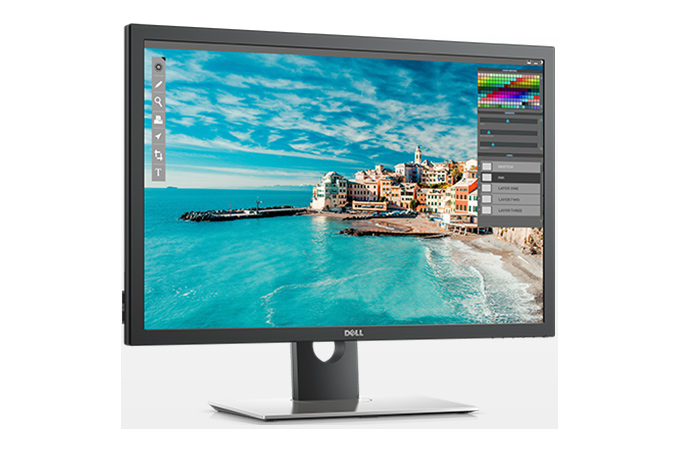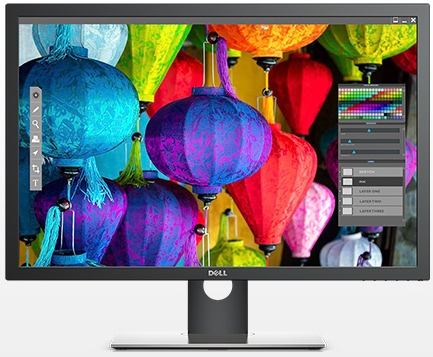Dell Introduces UltraSharp UP3017 30-Inch Professional Display with 16:10 Aspect Ratio and DCI-P3 Color Space
by Anton Shilov on September 9, 2016 4:00 PM EST- Posted in
- Monitors
- Dell
- IPS
- Ultrasharp
- DCI-P3

Nowadays, the vast majority of displays for desktop computers have 16:9 aspect ratio for various reasons (e.g., content, manufacturing aspects, etc.). However, there are a lot of professionals, who appreciate taller aspect ratios. Specifically for such people Dell this week introduced the latest iteration of its venerable line of 30" 16:10 2560×1600 monitors, with the latest model covering all three color spaces important for digital content creators.
The Dell UltraSharp UP3017 is a 30-inch display featuring an IPS panel, which can reproduce 1.07 billion colors and covers 99% of the Adobe RGB, sRGB, and DCI-P3 color spaces. The sRGB and the DCI-P3 color spaces are particularly important for video editors and animation designers, who do post-production work. Moreover, the DCI-P3 color space is used for digital movie projection by the U.S. movie industry, an increasing amount of Apple mobile devices, and is expected to be eventually adopted in televisions and for home cinemas. And given the professional audience the UP3017 is intended for, it comes pre-calibrated, with users able to further calibrate it using Dell’s UltraSharp color calibration software and X-rite colorimeters.
As for the other specifications, they do not differ too considerably from the UP3017's predecessor: a 2560×1600 resolution with a 60 Hz refresh rate, 350 nits typical brightness, 1000:1 static contrast, 6 ms response time in fast mode, W-LED backlighting (which a surprise for a display with a wide colour gamut) and 178° viewing angles. Do note however that unlike all of its 30” UltraSharp ancestors, the monitor has an adjustable stand that allows to rotate the panel clockwise or counter-clockwise to view the screen in portrait orientation.
| Dell UltraSharp UP3017 | |
| Panel | 30" IPS |
| Resolution | 2560 × 1600 |
| Refresh Rate | 60 Hz |
| Response Time | 6 ms gray-to-gray (fast mode) 8 ms gray-to-gray (normal mode) |
| Brightness | 350 cd/m² |
| Contrast | 1000:1 |
| Viewing Angles | 178°/178° horizontal/vertical |
| Color Saturation | 99% sRGB/REC 709 99% Adobe RGB 99% DCI-P3 |
| Pixel Pitch | 0.251 mm |
| Pixel Density | 101 ppi |
| Anti-Glare Coating | Yes |
| Inputs | 1 ×DP 1.2 (HDCP 1.4) 1 × mDP 1.2 (HDCP 1.4) 1 × DP 1.2 (out) with MST (HDCP 1.4) 2 × HDMI 1.4 (HDCP 1.4) |
| USB Hub | 4-port USB 3.0 hub, two ports support BC1.2 charging 2 USB Type-B upstream ports |
| Audio | line-out |
| Launch Price | $1249.99 |
Since the UltraSharp UP3017 is a professional display, it comes with a greater than usual number of display inputs. Overall we're looking at two HDMI 1.4 inputs, one DisplayPort 1.2 input, and one mDP 1.2 input. Furthermore, the display has one DP 1.2 output with MST, to allow daisy-chaining another display off of it. Unlike the UltraSharp U3014, the monitor does not support DL DVI-D input, though this should not be an issue for owners of anything close to a modern PC.
Meanwhile, like many high-end monitors, the monitor can be connected to two PCs with KVM, PBP and PiP features. In addition, the UltraSharp UP3017 has a quad-port USB 3.0 hub with two receptacles featuring BC1.2 charging capability.
The UltraSharp UP3017 is already available directly from Dell for $1249.99.
Source: Dell











52 Comments
View All Comments
Sttm - Friday, September 9, 2016 - link
Whats with the HDMI 1.4 ports that can't support the monitors resolution? Why not just go all out with DP and have 3 full size, and include an hdmi adapter?DanNeely - Friday, September 9, 2016 - link
HDMI 1.4 can do 2560x1600x60Hz@10bit color. (Support was added in 1.3 actually).HDMI 2.0 is only needed for 4k@60hz.
Sttm - Friday, September 9, 2016 - link
This got me confused because my monitor has 1.3 and doesn't support even 2560x1440, but then looking around online it seems like you dont actually have to support that to claim having 1.3.dsumanik - Saturday, September 10, 2016 - link
Mad props for pushing 16:10 monitor into the market!!!Sad props for the weak resolution and comical pricing 8(
jsntech - Monday, September 12, 2016 - link
Thiiiiiiiiiis. Please more 16:10.niva - Monday, September 12, 2016 - link
"Weak resolution and comical pricing" is this your weak attempt at being comical?It's a professional monitor, one of the best of it's kind, and the price is very competitive though I'm sure will go down quickly to about $1k. There are always 4k IPS screens at 32" that you can argue are better, look at those prices, and they don't necessarily sport the same calibration out of the factory or color depth standards.
peterfares - Saturday, September 10, 2016 - link
Lots of older WQHD/WQXGA monitors have HDMI 1.3 or 1.4 ports but don't support that resolution over them. I'm not sure why that is.What's even more odd is my Dell U3011. For years I thought that DP and DL-DVI were the only way to get 2560x1600 on it but recently I upgraded my GPU to one that only has 1 DL-DVI port, and I have two monitors. So I switched my U3011 to DisplayPort. That worked great and all, but DP has this annoying property where if you turn the monitor off, it gets disconnected from the PC and rearranges all the windows. So I plugged the HDMI in and as I remembered it only let me select 1920x1200. I went into the NVIDIA control panel and created a custom resolution of 2560x1600 60Hz and CVT-RB. Lo and behold, it works! It seems like the monitor's EDID simply doesn't specify 2560x1600 as a supported resolution over HDMI, but if you send the signal anyways it works just fine.
http://imgur.com/a/Tg0to
You could try doing the same thing and seeing if it works.
Macumazahn - Sunday, September 18, 2016 - link
OMG peterfares I am so grateful for this! I have five U3011 monitors and I always thought that 1920x1200 max on HDMI was the price I paid for being an early adopter. I tried your tip and it works, so call me five times grateful!Samus - Saturday, September 10, 2016 - link
The real insult is DisplayPort 1.2a supports 4K @ 60hz and full 30-bit 4:4:4 color, it was approved in December 2009 and fairly mainstream in laptops and business machines by 2011-2012. Most NVidia and ATI cards from the past 3 generations have at least DisplayPort 1.2a (current cards all appear to be 1.4a)I won't even get started discussing the native Adaptive Sync technology DisplayPort offered all along over HDMI.
Long story short, why is HDMI still around? It costs more to license, the connectors are more fragile, it is less capable, does not offer software upgradability, and it's years behind DisplayPort's advancements.
rib3 - Saturday, September 10, 2016 - link
One of the reasons Display Port can handle high bandwidth is tight restrictions on cable length. (Typically 3 meters max)This isn't an issue at a desk, but could be limiting in the rest of the house.